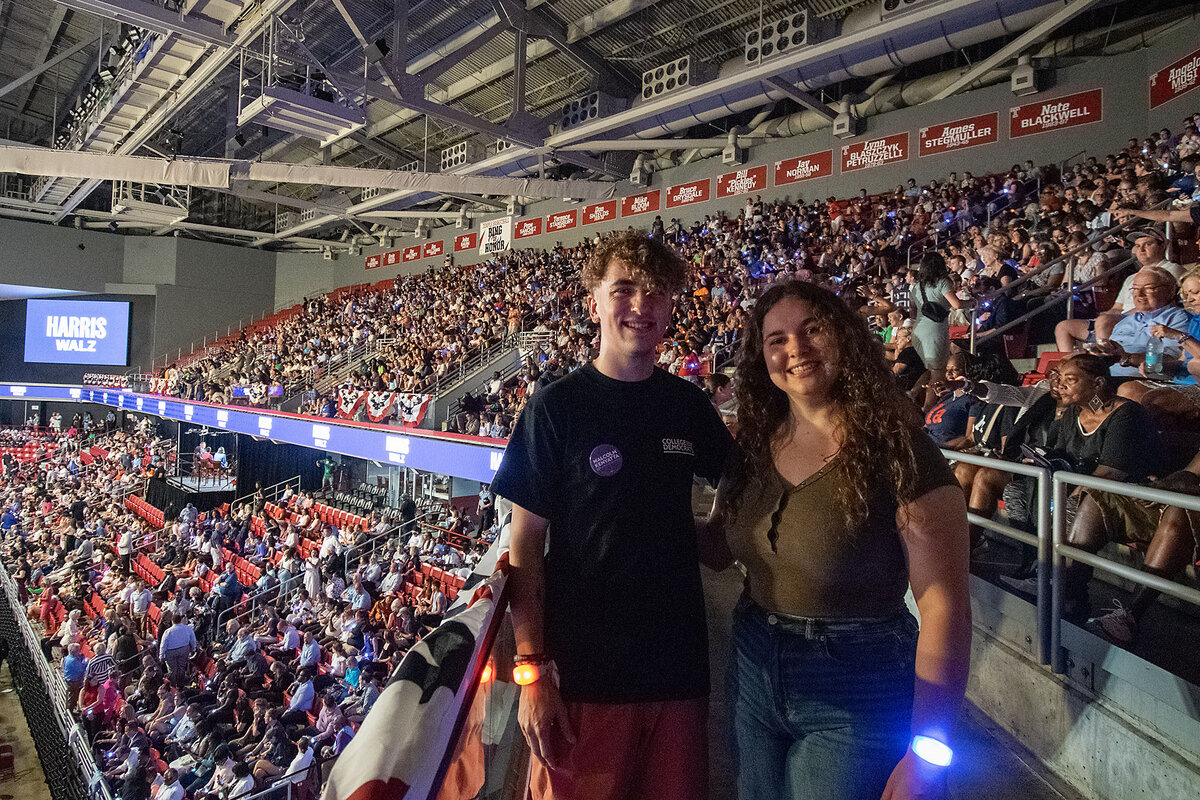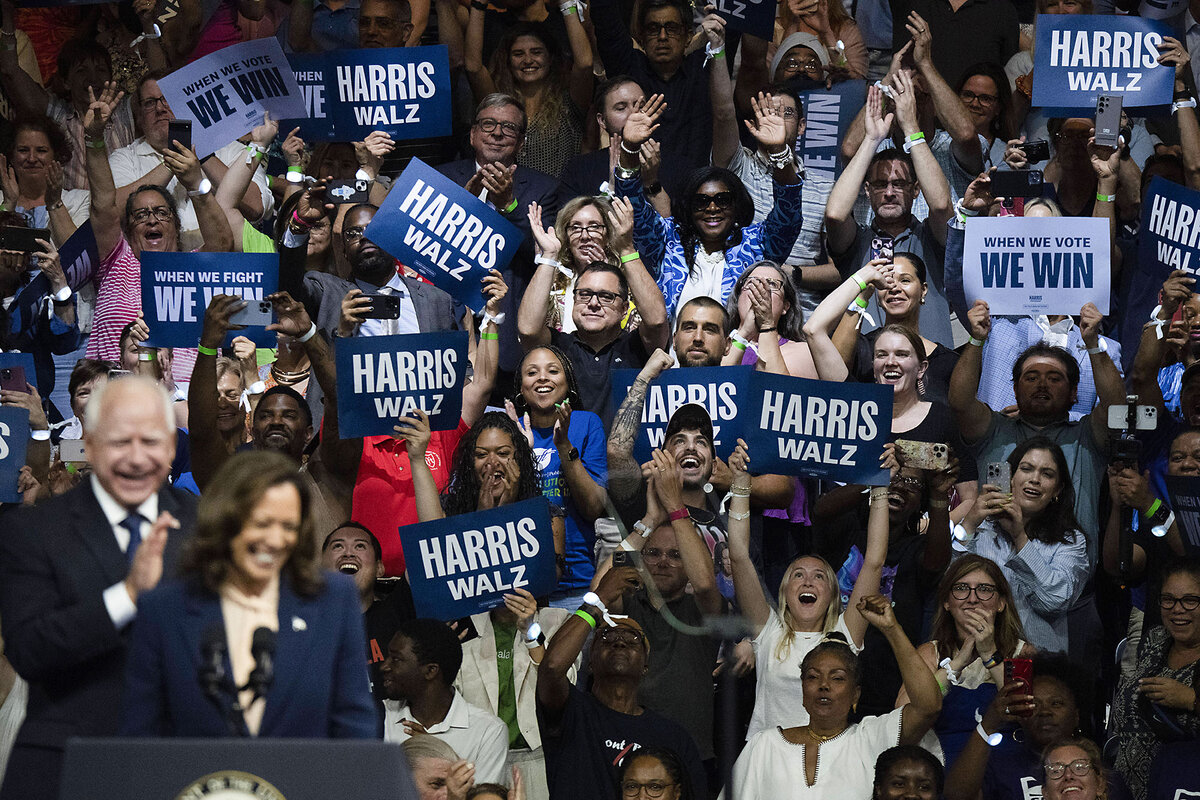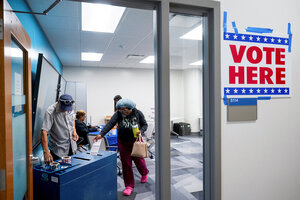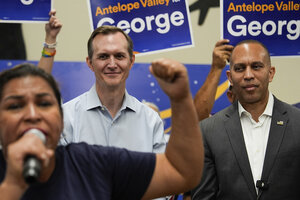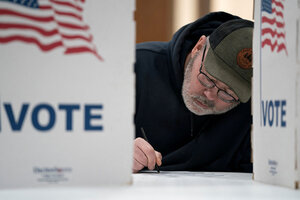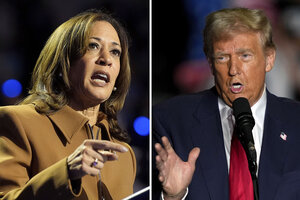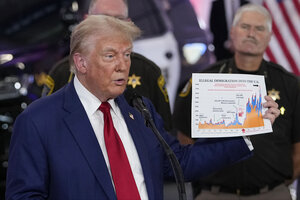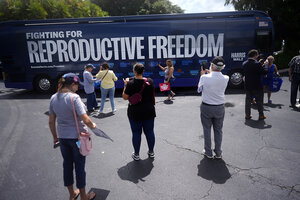Young voters have new energy: How big a boost for Harris-Walz ticket?
Loading...
| Philadelphia
College students Andrew Muth and Aaliyah Dittman drove six hours across Pennsylvania to attend a Kamala Harris rally in Philadelphia on Tuesday. “We had to,” says Ms. Dittman, shrugging and smiling. The next morning, they left at the crack of dawn to make it back to their summer jobs by 11 a.m.
The two students are board members of Pennsylvania College Democrats, and they’re gearing up for an intense fall. They and fellow volunteers were resolved to do their best to reelect President Joe Biden, but when he stepped aside and endorsed Vice President Harris to be the Democratic nominee, they say their jobs became instantly easier.
“It was hard to get college voters excited about Joe Biden, the person,” says Mr. Muth. “It was easier to make college voters scared of Donald Trump.” Now, with Ms. Harris leading the ticket, volunteers like Mr. Muth and Ms. Dittman say they can lean on positives about the vice president to engage young adults in the election while still pointing to Mr. Trump as a threat to their priorities. “We’re fired up; we’re knocking on doors.”
Why We Wrote This
This fall, both U.S. political parties will be seeking any edge in voter turnout that they can get. For Democrats, the new Harris-Walz ticket is energizing an important demographic – young people – as our reporter learned at a rally this week.
Democrats are encouraged by the sudden groundswell of enthusiasm from Generation Z and millennial voters. Supportive posts are flooding social media, campaign volunteers have skyrocketed, and polls indicate rising support in that bloc. The nonpartisan Vote.org reports that in the first 48 hours after Mr. Biden’s withdrawal, daily voter registrations increased sevenfold, nearly all of them by people under age 35. It’s a development that, in a tight race, could tip the election in the Democrats’ favor. But as always, the question is whether these indications will translate into votes.
“Enthusiasm at this stage is an important first step. But there are many steps that need to be taken to get young adults to the ballot box on election day,” says Elizabeth Matto, acting director of the Center for Youth Political Participation at Rutgers University.
Youth vote “pivotal” in swing states
It’s still too early to know how young voters will affect the election, she says, but “especially in swing states, every vote is going to count and the youth vote will be really pivotal.”
Pennsylvania, where Ms. Harris closed Mr. Biden’s gap with Mr. Trump to tie the state according to the Republican candidate’s own pollster, is ranked fourth in one estimate of states where young voters are the most likely to shape 2024 election results. Ahead of the Keystone State are swing states Wisconsin, Georgia, and Arizona.
While young voters are not a monolith, they tend to lean more left than right. In the 2020 election, 61% of young voters opted for Mr. Biden and 37% for Mr. Trump. In recent years, however, young men have shifted right. This spring, Mr. Biden’s lead over Mr. Trump was just 6 points among young men; in 2020, he was up by 26 points with that group. Until late July, young adult support for the Democratic ticket, at the time led by Mr. Biden, was waning.
But that was before Ms. Harris and her running mate, Minnesota Gov. Tim Walz, rose to top the Democratic ticket.
At their rally Tuesday at Temple University, she described herself and Governor Walz as “two middle-class kids” who made it to the heights of U.S. politics. The capacity crowd waved glowing bracelets and danced to Rihanna, Taylor Swift, and ABBA. While Mr. Biden’s campaign emphasized the importance of beating Mr. Trump and defending democracy, the Harris campaign has pivoted to a more future-focused message. Distinctly, she’s embraced a theme of joy – something her running mate joined in when he called the vice president a “joyous leader.”
Devon Spiva, a law student at the rally, says he’s headed out to canvass for the Harris-Walz ticket this weekend. There’s a “world of difference” when it comes to interest in the election now compared with a month ago, says Mr. Spiva. Friends who weren’t going to vote now plan to, he says.
Some young Pennsylvanians would have voted for Mr. Biden but didn’t want to volunteer for him. Maya, a rising college senior, fits that bill. Excited by the momentum behind Ms. Harris and her approach to policy, Maya, who wanted to use only her first name, now plans to volunteer for Ms. Harris. So do some of her friends, she says.
Issues also matter
Maya likes Mr. Biden’s domestic policy, which Ms. Harris mirrors, but not his foreign policy, particularly in the Middle East. She’s optimistic about Ms. Harris’ stance so far, but is watching to see how it develops.
Young people are more motivated by the issues that matter to them than they are loyal to a particular party, says Ruby Belle Booth, a researcher on the youth vote at Tufts University. Their priorities don’t differ much from those of the Democratic electorate as a whole. For both groups, the economy is still a top issue, followed by gun violence, reproductive rights, and climate change.
“This campaign, our campaign, is not just a fight against Donald Trump,” Ms. Harris told the crowd. Instead, she continued, “we fight for a future with affordable housing, affordable health care, affordable child care, paid leave.” And it’s a future, she said, with freedom from gun violence and government interference in a woman’s decision about what to do with her body.
Youth organizations are mobilizing
Over the past several weeks, organizations focusing on outreach and activation of younger voters have seen a combination of interest from first-time volunteers and renewed energy from current volunteers.
Students have been reaching out to Pennsylvania College Democrats, asking how to start local chapters, and friends are excited, looking for opportunities to get involved.
Mr. Biden has a long list of progressive achievements, but he “had trouble communicating them,” says Mr. Muth, the group’s communications director. “Harris can take credit and communicate them effectively.”
As he and Ms. Dittman, both from towns in rural Pennsylvania, juggle summer jobs and the start of the fall semester, they’re also launching a training program for volunteers that will include a focus on rural outreach. “Gen Z was on the sidelines in 2016, for the most part,” says Mr. Muth, who wasn’t of voting age then. He doesn’t see that this year, though.
Translating enthusiasm into action is where campaigns, college campuses, and organizers come in, all playing vital roles to help young adults navigate hurdles unique to them. Some may be first-time voters, unaware of things like early registration deadlines. Others may live in rural areas, far from polling places or outreach organizations. Many move frequently and may not know they need to update their registration.
Voting patterns in 2020 may have been the exception that proves the rule. The year saw historic young voter turnout, aided by pandemic efforts to make voting easily accessible, especially by mail, says Dr. Matto.
“No candidate, no campaign, no organization that cares about politics should take the youth vote for granted,” she says. “Young adults still need the support, the mobilization to get them to the ballot box.”






